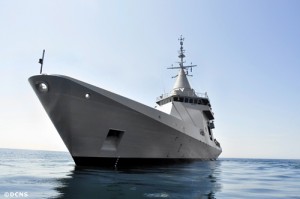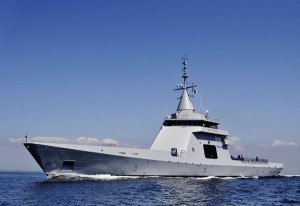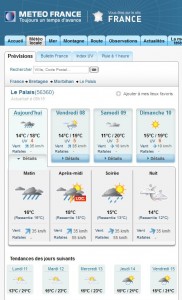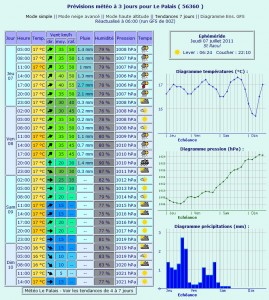Fer de lance de l’ambition de DCNS sur les marchés des navires militaires de petits et moyens tonnages, l’OPV Gowind L’Adroit a débuté le mercredi 27 juillet ses premiers essais en mer. Durant cette opération, les équipes DCNS vérifient les qualités nautiques du navire.
Quatorze mois après le début de sa construction, l’OPV Gowind L’Adroit a entamé sa phase d’essais en mer. Ce très innovant patrouilleur hauturier destiné à des missions de sauvegarde maritime est donc entré dans une nouvelle phase de sa réalisation, en conformité avec le planning de production.
« Cette première sortie à la mer constitue un symbole, fruit d’un remarquable travail entre les équipes DCNS, les investisseurs et coréalisateurs du projet et l’équipage de conduite du navire », souligne Marc Maynard, directeur du programme OPV Gowind. « Grâce à l’implication et aux savoir-faire de chacun, les ambitieux jalons industriels du programme se franchissent les uns après les autres avec succès », rappelle-t-il.
Au cours de cette période en mer, l’équipe à bord, composé d’une cinquantaine de techniciens, enchaîne les tests de façon intense pour s’assurer des bonnes performances nautiques du navire. Après avoir procédé aux essais des systèmes de sécurité – lutte contre les sinistres tels les incendies ou voie d’eau – les équipes ont vérifié le bon fonctionnement de la propulsion et la bonne manœuvrabilité du navire. En complément de ce programme seront également essayés les systèmes de navigation (calculs de vitesse, position, cap), les centrales inertielles (pour le positionnement du navire) ainsi que d’autres systèmes de la plateforme propulsée. Le bon déroulement de ces essais est facilité par l’étroite collaboration entre les membres du bord et l’équipage de conduite. Ce dernier, civil, est composé de 14 collaborateurs de la société VNavy, à qui DCNS a confié la charge de piloter le navire.
De retour à quai, l’aménagement des derniers locaux et les travaux de peinture va se poursuivre. Les équipes DCNS achèveront la construction du navire à la fin de l’année 2011.
Au-delà de cette première sortie en mer, cet événement constitue une nouvelle démonstration de la capacité de DCNS à relever le défi de concevoir et réaliser un navire particulièrement innovant dans un délai inférieur à 24 mois en respectant scrupuleusement le budget alloué.
Construit sur fonds propres et demeurant propriété de DCNS, l’OPV Gowind L’Adroit sera mis à disposition de la Marine nationale pendant 3 ans. L’objectif est d’obtenir pour ce produit une qualification « sea proven » (éprouvé à la mer), ce qui conférera au Groupe un atout sans équivalent pour la promotion de Gowind à l’international.
La Marine nationale pourra démontrer en haute mer la pertinence et la valeur opérationnelle de ce patrouilleur hauturier Gowind pour des missions actuelles et émergentes : surveillance de zone, lutte contre la piraterie et le terrorisme, police des pêches, lutte contre les trafics de drogue, préservation de l’environnement, aide humanitaire, recherche et sauvetage en mer, sécurité maritime.
Mesurant 87 mètres, le patrouilleur hauturier Gowind L’Adroit a une autonomie de 8 000 milles nautiques. Il peut rester plus de 3 semaines en haute mer, atteindre une vitesse de 21 nœuds et accueillir un hélicoptère et des drones. Il ne requiert qu’un équipage réduit de 30 personnes et peut transporter en plus une trentaine de passagers.
Les bâtiments de la famille Gowind présentent d’importantes innovations au service des marines, des commandos et des gardes-côtes : la visibilité sur 360° depuis la passerelle, une mâture unique pour une couverture radar à 360°, la mise en œuvre discrète et en sécurité en moins de 5 minutes d’embarcations rapides, l’exploitation de drones aériens et de surface… Cette gamme de navires Gowind bénéficie également de l’expertise de DCNS dans les systèmes d’information et de commandement. Les bâtiments de la gamme Gowind permettent ainsi une surveillance étendue de l’espace maritime et la détection automatique de comportements suspects. Celle-ci est réalisée grâce à la mise en réseau des communications entre les navires présents sur la zone et les centres à terre.
Reproduit depuis le site internet DCNS





